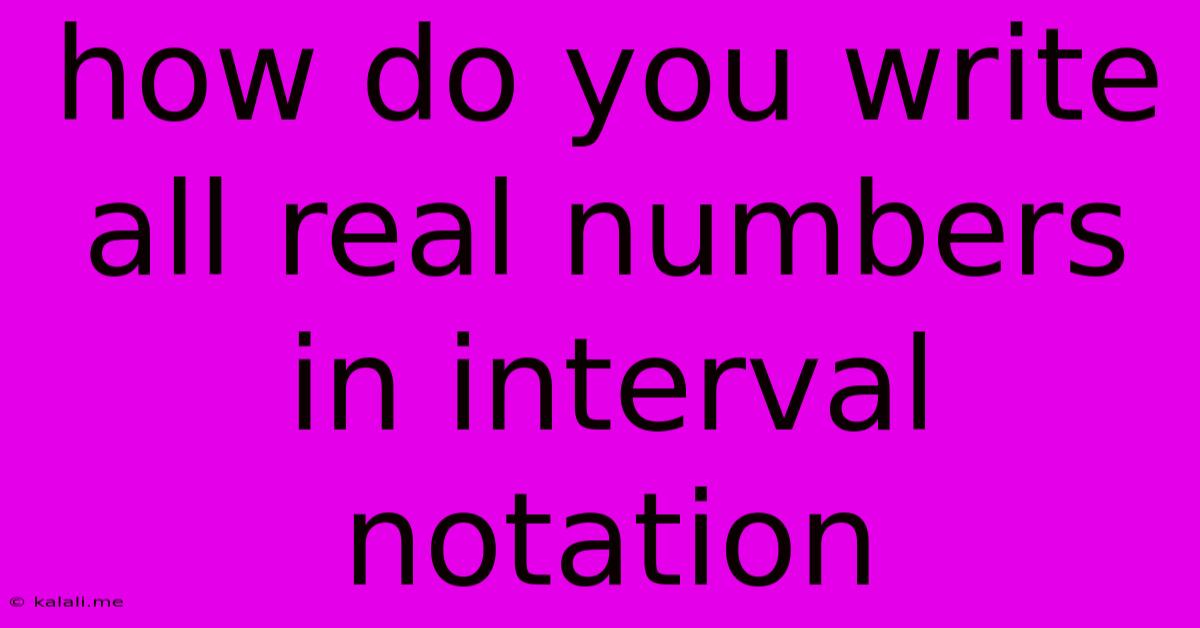How Do You Write All Real Numbers In Interval Notation
Kalali
May 24, 2025 · 2 min read

Table of Contents
How to Write All Real Numbers in Interval Notation
Interval notation is a concise way to represent sets of real numbers. It's particularly useful when describing domains and ranges of functions, solutions to inequalities, and other mathematical concepts involving real numbers. This article will explain how to express the set of all real numbers using interval notation, and provide examples to solidify your understanding.
Understanding Interval Notation Basics
Before diving into representing all real numbers, let's quickly review the basics of interval notation. We use parentheses () and brackets [] to denote whether the endpoints are included or excluded:
- Parentheses
(): Indicate that the endpoint is not included. This is used for inequalities with<or>. - Brackets
[]: Indicate that the endpoint is included. This is used for inequalities with≤or≥.
For example:
(2, 5)represents all real numbers greater than 2 and less than 5.[2, 5]represents all real numbers greater than or equal to 2 and less than or equal to 5.(2, 5]represents all real numbers greater than 2 and less than or equal to 5.[2, 5)represents all real numbers greater than or equal to 2 and less than 5.
Representing All Real Numbers
The set of all real numbers extends infinitely in both positive and negative directions. Therefore, we can't use finite endpoints in interval notation. Instead, we use the symbols -∞ (negative infinity) and ∞ (positive infinity) to represent the unbounded nature of the real number line. Crucially, infinity is not a number; it's a concept representing unboundedness. Therefore, we always use parentheses with infinity.
Consequently, the interval notation for all real numbers is:
(-∞, ∞)
This notation clearly and concisely indicates that the interval includes all numbers from negative infinity to positive infinity.
Examples and Applications
Let's look at a few scenarios where this notation is helpful:
-
Domain of a Polynomial Function: Polynomial functions, such as
f(x) = x² + 2x + 1, are defined for all real numbers. Their domain is represented as (-∞, ∞). -
Solving Inequalities: Consider the inequality
x² > -1. Since the square of any real number is always non-negative, this inequality is true for all real numbers. The solution set is (-∞, ∞). -
Range of an Exponential Function: The range of the function
f(x) = eˣis all positive real numbers. This can be expressed using the interval notation (0, ∞). However, the range of a function like f(x) = x² is [0, ∞), because the square of a number is always non-negative, and it can be 0.
Key Takeaways
Remembering that infinity is a concept, not a number, and therefore always uses parentheses, is essential for correctly using interval notation. Mastering this notation is crucial for effectively communicating mathematical concepts involving sets of real numbers in various mathematical contexts, making it a valuable tool for students and professionals alike. Understanding how to represent all real numbers as (-∞, ∞) is a fundamental step in this process.
Latest Posts
Latest Posts
-
How Many Months Is A Hundred Days
Jul 18, 2025
-
Mother And I Or Mother And Me
Jul 18, 2025
-
How Many Oz In One Water Bottle
Jul 18, 2025
-
How Many Dimes In A 5 Roll
Jul 18, 2025
-
How Do You Say Basil In Spanish
Jul 18, 2025
Related Post
Thank you for visiting our website which covers about How Do You Write All Real Numbers In Interval Notation . We hope the information provided has been useful to you. Feel free to contact us if you have any questions or need further assistance. See you next time and don't miss to bookmark.